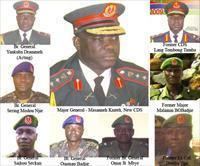 | ||
The Gambian Armed Forces (GAF) consists of the Gambia National Army, the National Republican Guard, and the Gambian Navy (including Marines). Recruits receive training from the Turkish-Gambian Training Team.
Contents
Organization
The Gambia Armed Forces or GAF is under the authority of the Ministry of Defence, with the Commander-in-Chief being the President (currently President Adama Barrow). Prior to the 1994 coup, the Gambian Army received technical assistance and training from the United States, People's Republic of China, Nigeria, and Turkey. With the withdrawal of most of this aid, the army has received renewed assistance from Turkey, the United States, Pakistan, Republic of China, and Libya. Pakistan sent an 18-month advisory team (the Pakistan Armed Forces Advisory Mission, or PAFAM) composed of one Brigadier from the Pakistan Army, one Captain of the Pakistan Navy, and one Group Captain from the Pakistan Air Force.
Members of the Gambian Armed Forces have participated in ECOMOG, the West African force deployed during the Liberian civil war beginning in 1990. Responsibilities for internal security and law enforcement rest with the Gambian Police/PIU force under the Inspector General of police and the Ministry of the Interior.
All branches are jointly governed by a Chief of Defence Staff, currently Lieutenant General Ousman Badji, with and Assistant Chief of Defence Staff, currently Major General Yankuba Drammeh.
The Gambian Police Force (GPF) is divided into General Duties, Community Policing, Mobile Traffic and Licensing Unit and the Police Intervention Unit (these are usually found policing border controls). The GPF and PIU are both part of GAF as they received rigorous military trainings both home and abroad.
All Police/PIU recruits are trained at the Gambian Forces Police Academy located in Banjuling .The academy was commanded by Brigadier General Lamin Olefah in 2012. The academy has four intakes of recruits every year (January, April, July and November). In 2011 the Gambian government decided to employ foreign police officers to provide specialist training. The foreign police contingent is directed by Colonel Neil Clark, a retired British police chief inspector who acts under direct warrant of the President. Since 2011 the GPF has also received training directly from the Turkish government. It is believed this special police program is funded by the United Nations. The Gambian government has stated the purpose of these overseas programs is to promote public confidence in the GPF.
Recent media reports in the country report that the police urgently require more police vehicles. The government is discussing this lack of transport issue with the British High Commission who have put forward a strategic plan to improve the situation.
The GAF Police Academy has a specialist Detective Training School (Major Steve Burris) where experienced police officers are sent to learn the basic of criminal investigation and intelligence gathering/collation. There is also a new GPF Firearms Training School where recruits learn basic weapon handling skills and experienced officers learn advanced weapon handling skills. All firearms courses are conducted by foreign police officers as is the detective school.
The Gambian government has in the past five years made advances to stop police officers abusing their authority and cut down on corruption. The foreign police contingent at the Gambian Forces Police Academy has made huge advances in this respect and continues to take appropriate action to further improve this problem. To date at least 16 senior GPF officers have been removed from their positions and prosecuted. Colonel Lamin Adjemeh is serving a 12-year prison sentence for corruption at the highest level. At least 22 middle managers (captains) have also been arrested and are on parole waiting for a court date. On June 25, 2013 Colonel Neil Clark was awarded the Order of the Gambia (OG) by the President for services to the GPF over a period of eight years.
Army
The Gambian National Army (GNA) had a strength of 1,000 personnel in 2013 (900 from the GNA, 100 from the Gambian Air Force). The GNA is formed of two infantry battalions, an engineering squadron, and smaller logistics, signals and intelligence units, plus the presidential guard company. The GNA has upgraded its equipment to provide greater firepower and mobility. It now has several armoured cars (two of which are based at State House) and heavier caliber vehicle-mounted weapons.
It is not clear to which branches of the Gambian Armed Forces (GAF) new recruits are deployed. There is also an HIV/AIDS prevention programme unit within the GAF.
Army service is voluntary.
National Republican Guard
An amendment to the Gambia Armed Forces Bill in April 2008 included the creation of a new branch of the GAF, the National Republican Guard (NRG).
The NRG is thought to have a strength of 50 personnel, and is made up of a State Guard unit, a Special Forces unit, and a Presidential Guard unit.
Other branches
Missions
According to the Stockholm International Peace Research Institute (SIPRI), the Gambia has contributed troops to a number of peacekeeping operations:
Military manpower - availability
Military expenditures
Aircraft inventory
The Gambian army operates a single Sukhoi Su-25 Frogfoot attack jet and four propeller-driven aircraft.
Current aircraft
